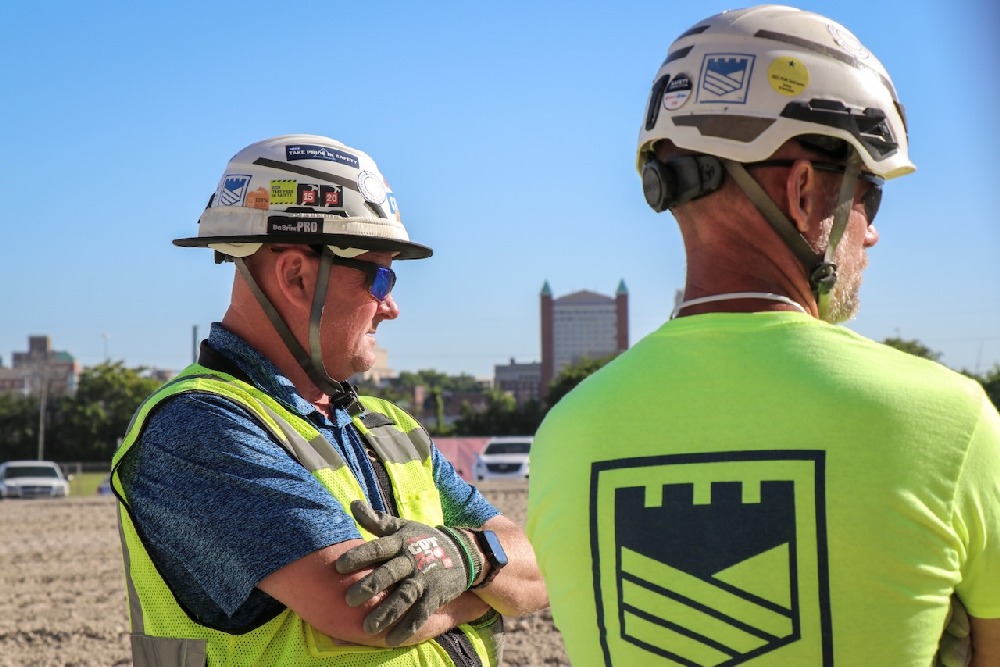
4 ways the ‘boots on the ground’ outperform technology
By David Denny
When Roy Hardester began his construction career in 1996, he relied primarily on paper plans, two-way radios and face-to-face interactions to stay connected to his colleagues and complete his daily tasks. Today, as superintendent at Castle Contracting, he uses an iPad tablet, mobile phone and advanced software programs to keep people and projects on track.
Having real-time access to the latest digital drawings and models is more convenient and efficient for all team members. “If someone has a problem on a job, you can send them the information they need in minutes, rather than having to gather all the information, print it off and head out to the job, hoping that you didn’t forget anything,” he says.
Truth be told, technology has streamlined nearly every aspect of managing and delivering construction projects — from tracking time and material usage to surveying the ongoing progress of jobs.
Now, with the advent of artificial intelligence and machine learning, the construction industry has entered a whole new domain of innovation. While it remains to be seen how these emerging technologies will impact daily construction work, they will never fully replace people. That’s because construction is — and always will be — a hands-on enterprise that relies on human skill, craftsmanship and ingenuity.
The following are four ways your crew can continue to outperform technology on the jobsite:
1. Matching the best person to each task
Technology can’t replicate the skill and finesse required to identify the best crew member(s) to complete a specific task, which is arguably one of a superintendent’s most important roles. “You can use apps to track statistical data and gather a lot of information, but I don’t think there’s ever going to be an app that can pick the right person for a job,” notes Hardester.
2. Confirming data accuracy and filling in gaps
The use of drones to visualize and track the progress of construction jobs demonstrates how technology can improve the efficiency of projects. Yet, while drones can conduct topographic surveys in a fraction of the time it takes to conduct a traditional land surveying process, it isn’t a foolproof system. “A drone is only as good as the information you give it to work with,” says Castle Project Manager Zach Kelly. “If the ground control points are off, something blocks the signal or we’ve got a gap in our data, it can throw off the results.” And, as he’s discovered, challenging sites such as an undeveloped grassy field can conceal a ditch, hole or mound that isn’t detected by a drone. “That’s why it’s important to have some other verifications and checks and balances in place,” he says.
3. Spotting potential safety risks
Technology tools are increasingly useful for tracking safety trends and communicating urgent updates — including weather alerts and emergency situations — with team members. But it’s the experienced crew members working on the ground who are best positioned to identify real-time safety risks — whether it’s a washed-out roadway, exposed wire or excess debris on a jobsite. They’re also equipped to develop the most effective strategies to mitigate these risks.
4. Connecting with colleagues
People thrive on human interactions, and nowhere is that more evident than on a construction jobsite, where individual crew members must collaborate with others to successfully deliver a job. Given the well-documented mental health crisis that the construction industry continues to face, staying connected with colleagues is essential. “We don’t have access to software or an app that replaces being personable with our workforce and seeing when people are struggling or having a hard time,” explains Hardester. “Letting them know that you care about them goes a long way.”
As technology advancements continue to improve the productivity, efficiency and precision of construction work, it can be daunting to wonder whether it may eventually replace humans completely. Thankfully, the answer is an emphatic “no.” Rather than removing humans from the equation, AI and other emerging technologies have the potential to take over the more monotonous tasks and assist people in doing the core functions of their jobs more effectively.
In the words of Castle Superintendent Ray Cureton, “Boots on the ground are still the most important tool for moving jobs forward.”
David Denny is director of field operations, Castle Contracting


 Join our thriving community of 70,000+ superintendents and trade professionals on LinkedIn!
Join our thriving community of 70,000+ superintendents and trade professionals on LinkedIn! Search our job board for your next opportunity, or post an opening within your company.
Search our job board for your next opportunity, or post an opening within your company. Subscribe to our monthly
Construction Superintendent eNewsletter and stay current.
Subscribe to our monthly
Construction Superintendent eNewsletter and stay current.